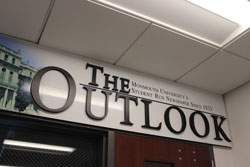At the fourth annual Dean’s Seminar hosted by the School of Science on Friday, Feb. 22, Dr. Robert P. Kirshner, Clowes Professor of Science at Harvard University, lectured on how the universe is not only expanding, but accelerating in the process.
“We thought we could measure that effect by looking at objects nearby and far away and seeing how fast they are receding from us,” Kirshner said. Therefore, if the universe is slowing down, the rate of its expansion must have been faster in the past than it is now or it could be that it is speeding up where the opposite would hold true. The measurements of distances and velocities of light emitted from exploding stars known as supernovae support the latter theory.
As a nearby supernova occurs, its light travels to us through space at 300,000 kilometers per second. If the universe is speeding up during the time the light is in flight, it stretches out more, increasing the distance traveled, thereby causing the supernova to appear a little dimmer. If the universe is slowing down however, the light traveling to you would travel a shorter path and the supernova would seem a little brighter.
This is in accordance with the Doppler Effect which accounts for the difference between observed frequency and emitted frequency between an observer and a source, respectively. For instance, as an ambulance approaches you, you hear a high-pitched siren with an elevated observed frequency with respect to the emitted frequency. As the ambulance passes you, a lower pitched siren is heard with a lower corresponding frequency. The same applies to supernovae. As the light from a receding supernova approaches us, as in the expansion of the universe, a smaller light frequency, or a higher wavelength is observed, in a phenomenon known as a red-shift.
In relation to the rate of the universe’s expansion exceeding the speed of light, “There is no riddle of relativity,” Kirshner said. “What relativity tells you is that one object cannot pass another object at the speed of light.”
He added that the overall expansion can make it so that the expansion itself is going faster than the speed of light meaning that far away, objects are increasingly red-shifted so they get dimmer and the energy of each photon decreases so eventually you cannot see them at all.
“We know that there is evidence that the expansion of the universe, which people have known about since the 1930’s, is speeding up,” Kirshner said. “Everyone expected it to slow down due to gravity, but it’s speeding up. So there must be some other component of the universe that causes that…we call it dark energy.”
Kirshner added that Einstein thought of something similar in 1917 known as the cosmological constant, which allowed for a stationary universe. “The modern way of thinking about that would be that there could be energy associated with empty space itself. It’s empty, but not without qualities,” Kirshner said.
Even though the gravitational force appears powerful as it holds our cars smack against the roads, it pales in comparison to other fundamental forces as its associated length remains quite miniscule. Due to this nature, the uncertainty in energy, attained from quantum mechanical calculations, is “quite large.”
“So it wouldn’t be at all amazing if there is some energy associated with empty space,” Kirshner said.
Astronomical observations of exploding stars halfway across the universe seem to show that there is evidence for the acceleration of the universe and for the presence of some dark energy. “It might be the cosmological constant but that is not to say we really know the whole story.” Kirshner continued, “It may have some other qualities that have not been appreciated yet, but it looks like dark energy is what we attribute the accelerated expansion to.”
This dark energy, which may be a property of empty space, would theoretically not be diluted if space were to expand. So as more space was to come into existence due to the expansion of the universe, more dark energy should appear, allowing the universe to accelerate faster. To figure out the true nature of dark energy however, actual data is needed because we do not exactly know the true nature of dark energy.
Has dark energy always been around? Kirshner said that the assumption is that it always has been there and it had such a small value in the early days of the universe that the density of matter was higher than it is now so the universe would have been slowing down due to the presence of matter. It is only as the universe spreads out that the matter gets diluted that the density of matter decreases to be comparable to the density of dark energy. Kirshner said, “Apparently, this crossover point actually occurred about 5 billion years ago which is the range of our observations and also about the age of the earth.”
Combining quantitative cosmological observations with theoretical models of the composition of the universe, scientists have described the dark energy to consist of about “73 percent of the universe, with 23 percent dark matter, and less than 4 percent actual atoms,” according to Kirshner. That four percent consists of baryonic matter, elementary particles such as protons and neutrons which collectively form everything we are familiar with: from our muscles and cell-phones to the rings of Saturn and distant supernovae.
On the other hand, dark matter is a little bit different. Kirshner said that when you look at a galaxy, the stars in it are orbiting the mass of the galaxy and the velocity of the orbits does not decrease as you go to the outer portions of the galaxy. Therefore, the mass distribution must be extended and very large compared to the stars such that the galaxy is embedded in the dark matter.
Since our own galaxy observes the same behavior, we ought to be going through a mist or a fog of these dark matter particles. “We are going at 250 kilometers per second so it’s like driving in the rain, [these particles] ought to be hitting the windshield,” Kirshner said.
But because this dark matter does not appear to interact with electromagnetic radiation like baryonic matter does, the former seems to be invisible. The experiments for the meticulous determination of dark matter using underground particle detectors are still ongoing. “The current results are all null results, but we still believe it,” Kirshner said.
Brandon Edward Hayes, senior chemistry major, recollected that “Kirshner’s talk provided wonderful (and at times comical) insight into the ever-changing model and history of the universe. His charismatic persona and love for his work made the presentation enjoyable for all who attended, not just the scientifically driven.”
Kirshner graduated from Harvard College in 1970 and received a Ph.D. in Astronomy at Caltech. He was a postdoc at the Kitt Peak National Observatory, and was on the faculty at the University of Michigan for nine years. In 1986, he moved to the Harvard Astronomy Department. He served as chairman of the Department from 1990-1997 and as the head of the Optical and Infrared Division of the CFA from 1997-2003.
Kirshner is an author of over 200 research papers dealing with supernovae and observational cosmology. His work with the High-Z Supernova Team on the acceleration of the universe was dubbed the “Science Breakthrough of the Year for 1998” by Science Magazine. Kirshner and the High-Z Team shared in the Gruber Prize for Cosmology in 2007. In 2011, two of his former graduate students, Brian Schmidt and Adam Reiss, shared in the Nobel Prize in Physics for this work.



